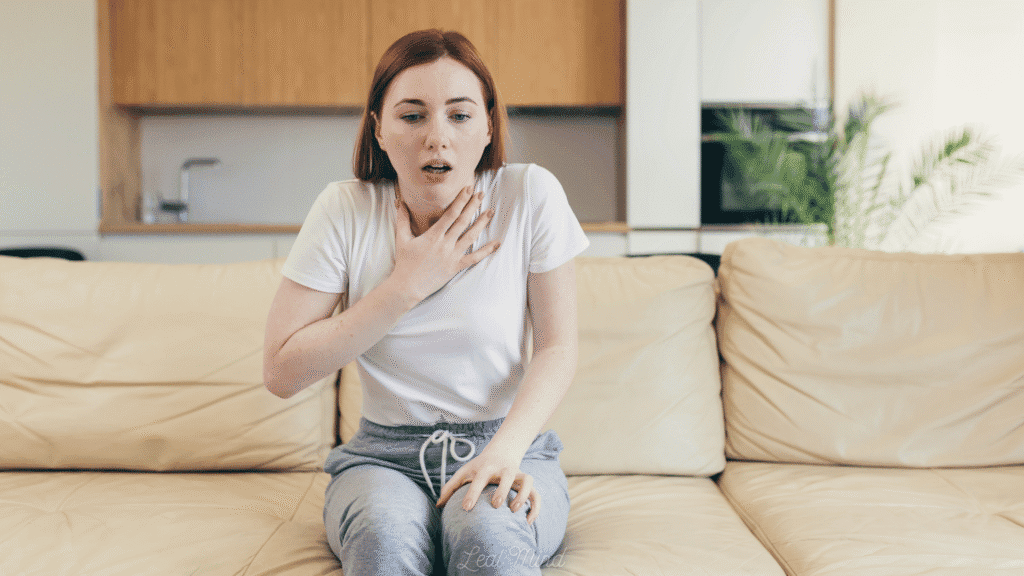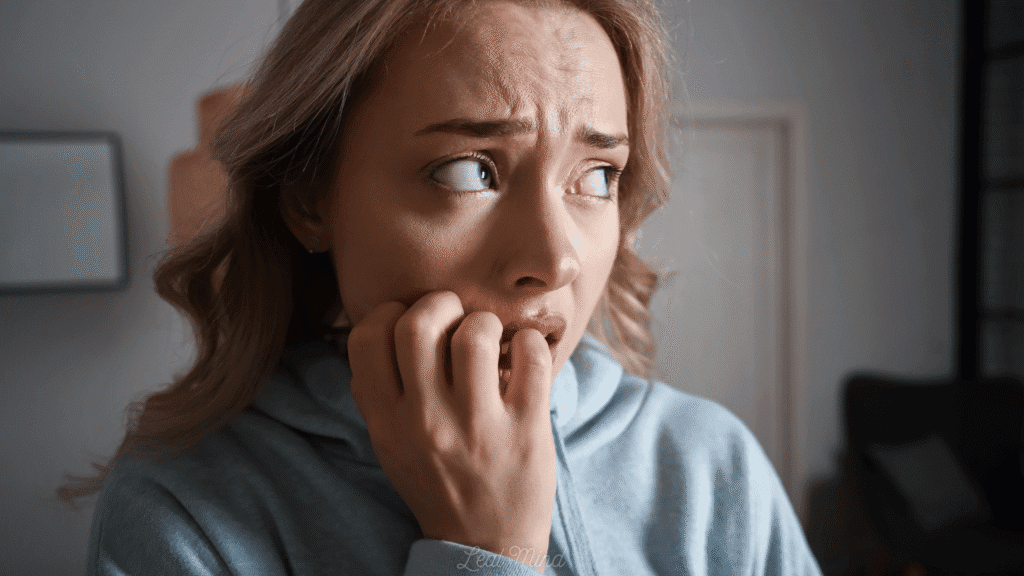Panic disorder symptoms can be overwhelming and often mistaken for other health issues, making early recognition critical for effective treatment. Characterized by sudden, intense episodes of fear—commonly known as panic attacks—this mental health condition can severely impact daily functioning. Understanding the signs of panic disorder, such as rapid heartbeat, shortness of breath, and fear of losing control, is essential for identifying the problem and seeking timely support. If you’re experiencing these symptoms frequently, it’s important to learn how to stop a panic attack using expert-approved techniques to regain calm quickly and safely. In this article, we’ll explore the most common and hidden symptoms of panic disorder to help you recognize when it’s more than just anxiety.
Table of Contents
What Is Panic Disorder?
Panic disorder isn’t just about having occasional anxiety. I’ve found that it’s a specific mental health condition characterized by recurring, unexpected panic attacks followed by persistent worry about future attacks and their consequences.

Definition and Diagnostic Criteria (DSM-5)
According to the Diagnostic and Statistical Manual of Mental Disorders (DSM-5), panic disorder involves experiencing unexpected panic attacks that come “out of the blue” without an obvious trigger. To receive this diagnosis, a person must have:
- Recurrent unexpected panic attacks
- At least one month of persistent concern about having another attack
- Significant behavioral changes related to the attacks (like avoiding certain places)
- Symptoms that aren’t better explained by other conditions
The difference between panic disorder and simply having a panic attack is the ongoing worry. For instance, someone with panic disorder might avoid exercise because increased heart rate reminds them of panic symptoms, creating a cycle of fear. According to the Mayo Clinic, panic disorder is a condition characterized by sudden episodes of intense fear that trigger severe physical reactions. The National Institute of Mental Health outlines evidence-based treatments for panic disorder, including CBT and medication for long-term symptom management.
Who’s at Risk?
Panic disorder typically begins during late adolescence or early adulthood, though it can start at any age. Several factors increase someone’s likelihood of developing this condition:
- Family history: If your parents or siblings have panic disorder, your risk increases significantly
- Personal history of trauma: Childhood abuse or significant stressful events can trigger panic disorder
- Other mental health conditions: People with depression, other anxiety disorders, or substance use problems face higher risks
- Gender differences: Women are twice as likely as men to develop panic disorder
- Personality traits: Those with heightened sensitivity to anxiety or who tend toward negative emotions may be more vulnerable
Certain health conditions can also mimic or trigger panic attacks, including thyroid problems, cardiac issues, and medication side effects. Furthermore, major life transitions or periods of significant stress often precede the first onset of panic symptoms. Since women are more prone to panic disorder, it’s critical to understand the unique mental health challenges women face.

Key Symptoms of Panic Disorder
Understanding the symptoms of panic disorder is vital for early recognition and treatment. When experiencing panic disorder, your body goes through intense physical and mental changes that can feel overwhelming.
Physical Symptoms (Heart pounding, sweating, etc.)
The physical manifestations of panic disorder are often the most noticeable aspect of an attack. These symptoms typically peak within minutes and can include:
- Racing heartbeat or heart palpitations that feel like your heart is pounding out of your chest
- Shortness of breath or hyperventilation
- Chest pain or discomfort that might mimic a heart attack
- Sweating, hot flashes, or chills
- Trembling or shaking uncontrollably
- Nausea or stomach distress
- Dizziness, lightheadedness, or feeling faint
- Numbness or tingling sensations, particularly in the extremities
Many people initially mistake these physical symptoms for a medical emergency, which only intensifies their fear.
Emotional and Cognitive Symptoms (Fear of dying, loss of control)
Beyond the physical sensations, panic disorder involves intense psychological distress. The emotional symptoms can be equally debilitating:
- Overwhelming fear of dying or having a heart attack
- Sense of impending doom or danger
- Fear of losing control or “going crazy”
- Feeling detached from reality (derealization) or from yourself (depersonalization)
- Intense worry about when the next attack will occur
- Developing avoidance behaviors related to places where attacks happened
These emotional patterns often overlap with hidden depression symptoms, making diagnosis and treatment more nuanced.
Duration and Frequency of Panic Attacks
Panic attacks typically last between 5-20 minutes, although some people report symptoms lasting up to an hour. Most attacks reach their peak intensity within 10 minutes before gradually subsiding.
Regarding frequency, this varies widely among individuals. Some people might experience several attacks daily, while others might have just a few attacks monthly. Nonetheless, what defines panic disorder is not merely having panic attacks but developing persistent worry about future attacks and changing behaviors to avoid them.
Even between full-blown attacks, many people with panic disorder experience persistent anxiety and limited-symptom attacks that don’t include all the symptoms of a full panic attack.
Panic Attack vs Anxiety Attack: Key Differences
Many people confuse panic attacks with anxiety attacks, yet these are distinct experiences with important differences. Recognizing which one you’re experiencing helps determine the appropriate response and treatment.
Panic attacks are sudden, intense surges of fear that reach their peak within minutes. They’re characterized by specific physical and psychological symptoms including racing heart, shortness of breath, fear of dying, and a sense of detachment. The defining quality of panic attacks is their abrupt onset—they often strike without warning or an obvious trigger.
In contrast, anxiety attacks (not officially defined in diagnostic manuals) typically build gradually in response to a stressor. They’re marked by persistent worry that intensifies over time rather than hitting suddenly. While anxiety attacks share some symptoms with panic attacks—like increased heart rate and worry—they’re generally less severe.
Here’s a quick comparison:
| Feature | Panic Attack | Anxiety Attack |
| Onset | Sudden, often without trigger | Gradual, usually has identifiable cause |
| Duration | Typically 5-20 minutes | Can last hours or even days |
| Intensity | Severe, often feels life-threatening | Moderate to severe, rarely feels life-threatening |
| Physical symptoms | More intense (racing heart, chest pain, dizziness) | Less intense but similar symptoms |
| Fear content | Often fear of dying or losing control | Usually focused on specific concerns |
Unlike panic attacks, which can occur unexpectedly even during sleep or relaxation, anxiety attacks almost always connect to a perceived threat. Moreover, panic attacks are officially recognized in diagnostic manuals as part of conditions like panic disorder, whereas “anxiety attack” remains a colloquial term.
Regardless of which you experience, both conditions respond well to proper treatment. Cognitive behavioral therapy works effectively for both, though medication approaches may differ. Specifically, panic attacks sometimes require fast-acting medications for immediate relief, while anxiety might benefit from longer-term treatments.
Distinguishing between these experiences helps ensure you receive appropriate care and develop effective coping strategies tailored to your specific condition.

Early Warning Signs of a Panic Attack
Recognizing the early warning signs of a panic attack can be life-changing for those who experience these frightening episodes. For many individuals, panic attacks don’t always strike completely without warning—there are often subtle signals your body sends before the full attack develops. Many individuals also report early warning signs of anxiety symptoms that precede full-blown panic attacks—recognizing them can be the key to better management.
How It Builds Up
Panic attacks typically last between 5 to 20 minutes, with symptoms usually reaching their peak within 10 minutes. Initially, you might notice a sudden surge of intense anxiety that feels overwhelming and disproportionate to your situation. This anxiety often appears quickly and may seem unrelated to your current circumstances.
As the attack builds, physical symptoms begin to emerge without an obvious cause. These early physical warning signs include:
- Rapid heartbeat or heart palpitations
- Profuse sweating
- Trembling or shaking
- Shortness of breath or feeling like you can’t catch your breath
- Dizziness or lightheadedness
Emotionally, you might experience a sense of disconnection from your surroundings—feeling as if you’re in a dream or not fully present in your body. This sensation, known as derealization or depersonalization, often precedes a full-blown attack.
Recognizing Triggers
Contrary to popular belief, not all panic attacks occur “out of the blue.” In fact, many are triggered by specific situations or substances. Consequently, identifying your personal triggers becomes essential for management.
Common triggers include:
- Chronic or acute stress—the number one trigger for most people
- Excessive caffeine consumption
- Certain medications, especially those for birth control, cold symptoms, or weight loss
- Crowded or noisy environments
- Financial worries or relationship conflicts
- Health diagnoses or concerns about medical conditions
- Intense physical exercise [152]
Panic attacks can be categorized as either expected or unexpected. Unexpected attacks truly come “out of the blue,” while expected attacks are either situationally bound (always occurring in specific situations) or situationally predisposed (more likely in certain situations but not guaranteed).
Understanding your unique warning signs and triggers empowers you to implement coping strategies before an attack fully develops.

When to Seek Medical Help
Seeking timely medical help for panic disorder symptoms can prevent the condition from worsening and significantly improve quality of life. As someone who studies this condition, I’ve noticed many people delay treatment until symptoms become severe.
Recurrent Episodes
It’s time to consult a healthcare provider if you experience recurring, unexpected panic attacks. Medical attention becomes necessary primarily when:
- You’ve had multiple panic attacks that seem to come “out of the blue”
- You spend at least one month worrying about having additional attacks
- You’re changing your behavior to avoid situations where attacks might occur
- Your panic attacks continue even after periods without symptoms
Even if you haven’t been diagnosed with panic disorder yet still experience panic attacks, treatment remains beneficial. Left untreated, occasional panic attacks can intensify and potentially develop into full panic disorder or phobias.
Disruption of Daily Life
Beyond frequency, the impact on your daily functioning serves as a crucial indicator that professional help is needed. Consider seeking medical attention immediately when:
- Anxiety interferes with school, work, or relationships with friends and family
- You live in constant fear, ruining your quality of life
- Chronic anxiety disrupts your daily activities
- You’ve developed avoidance behaviors that limit your activities and social interactions
- You find yourself distancing from friends, family, and others who could provide support
Additionally, seek emergency medical care if you experience chest pain, breathing difficulties, or lose consciousness, as these symptoms can resemble serious medical conditions like heart attacks.
Many people suffering from panic disorder hesitate to seek help due to embarrassment or fear of being labeled a hypochondriac. However, professional intervention typically reduces symptoms within several weeks, with significant improvement or resolution often occurring within months.
Remember that panic disorder is highly responsive to treatment. Through appropriate care, you can regain control over your symptoms and prevent the condition from limiting your potential.
Causes and Risk Factors
The exact cause of panic disorder remains something of a medical mystery, yet researchers have identified several factors that likely contribute to its development. Understanding these underlying mechanisms helps explain why some people develop panic disorder symptoms while others don’t.
Genetic Links
Panic disorder runs strongly in families. First-degree relatives of people with panic disorder have a 40% increased risk of developing the condition themselves. Twin studies have demonstrated heritability estimates as high as 48%, confirming that genetics play a substantial role. Despite this clear genetic component, identifying specific genes has proven challenging. Nevertheless, researchers have found several genetic markers potentially linked to panic vulnerability, including variations in the COMT gene (affecting dopamine metabolism) and MAOA gene (affecting monoamine regulation). Additionally, studies have identified potential risk loci on chromosomes 13q, 14q, 4q31-q34, 22q, and 9q31. Gender-specific genetic associations exist as well, potentially explaining why women experience panic disorder at higher rates than men.
Brain Chemistry
Imbalances in several neurotransmitters likely contribute to panic disorder symptoms. Four key chemical messengers play crucial roles: serotonin (affecting mood regulation), dopamine (influencing rewards and energy), norepinephrine (released during stress responses), and GABA (producing calming effects). Furthermore, dysfunction in your amygdala—the brain’s fear processing center—appears central to panic disorder. This may explain why people with panic disorder show heightened sensitivity to carbon dioxide, a response linked to the brain’s suffocation alarm system. Indeed, neuroimaging studies show altered activity in fear circuit structures among those with panic disorder.
Environmental Stressors
Even with genetic predisposition, environmental factors often trigger panic disorder onset. Acute stressful life events strongly correlate with the beginning of panic episodes. Childhood experiences, particularly emotional maltreatment, attachment issues, or abuse, can increase vulnerability. Interestingly, chronic physical pain appears connected to anxiety disorders—almost half of primary care patients with chronic pain had at least one comorbid anxiety disorder. Previous respiratory diseases likewise increase panic disorder risk, possibly explaining why some people develop panic with prominent respiratory symptoms. Major life changes such as divorce, bereavement, or having a baby also increase susceptibility.
The interplay between these genetic, neurobiological, and environmental factors creates unique vulnerability patterns, explaining why panic disorder manifests differently across individuals.

How Panic Disorder Is Diagnosed
Getting an accurate diagnosis of panic disorder involves a specific process that doctors follow carefully. When you visit a healthcare provider with symptoms of panic attacks, they’ll conduct a comprehensive evaluation to determine whether you have panic disorder or another condition.
Initially, your doctor will perform a complete physical examination and may order blood tests to check your thyroid function and rule out other medical conditions that can mimic panic symptoms. An electrocardiogram (ECG) might be requested to evaluate your heart, as many panic symptoms can resemble cardiac problems.
After excluding physical causes, healthcare providers diagnose panic disorder based on criteria from the Diagnostic and Statistical Manual of Mental Disorders (DSM-5). According to these guidelines, you must experience recurrent unexpected panic attacks, with at least one attack followed by one month or more of:
- Persistent worry about having additional attacks or concern about their implications (such as “going crazy” or losing control)
- Significant behavioral changes related to the attacks (like avoiding certain activities or situations)
Notably, your doctor will ensure these symptoms aren’t caused by substance use, medications, or another mental health condition such as social anxiety disorder, OCD, PTSD, or separation anxiety.
Throughout this process, your healthcare provider might ask you to complete psychological questionnaires. For instance, the Patient Health Questionnaire for PD screens for panic disorder by asking about specific symptoms like shortness of breath, racing heart, chest pain, and fear of dying during attacks.
Typically, if you’ve had four or more panic attacks and experience constant fear of having another, healthcare professionals will consider a panic disorder diagnosis. Yet even without meeting the full criteria for panic disorder, experiencing panic attacks still warrants treatment, as untreated attacks can worsen over time.
Ultimately, being honest with your healthcare provider about your symptoms is essential for receiving appropriate care and beginning the path toward effective management.
Coping With Panic Disorder
Effective management of panic disorder requires both immediate strategies for during attacks and comprehensive long-term approaches. Fortunately, about 80% of people who complete a course of Cognitive Behavioral Therapy (CBT) become panic-free by the end of treatment.
Immediate Calming Techniques
When panic strikes, these evidence-based techniques can help reduce symptom intensity:
- Focus on breathing: Practice slow, deep breaths through your nose and out through your mouth while counting to five. This counters hyperventilation and activates your body’s calming response.
- Use grounding methods: The 5-4-3-2-1 technique helps reconnect with reality during an attack by acknowledging five things you see, four things you can touch, three things you hear, two things you smell, and one thing you taste.
- Practice progressive muscle relaxation: Systematically tense and then release different muscle groups, starting with your fingers or toes and working through your entire body.
- Challenge catastrophic thoughts: Question negative interpretations by reminding yourself that panic attacks, though frightening, aren’t dangerous or life-threatening.
Long-Term Treatment Options (CBT, medication, etc.)
For sustained improvement, experts recommend these approaches:
CBT stands as the gold standard treatment, typically delivered in 7-14 weekly sessions. Effective CBT for panic disorder includes several key components: cognitive restructuring to reframe catastrophic thoughts, interoceptive exposure (confronting feared bodily sensations), and in-vivo exposure to avoided situations.
Medication options include selective serotonin reuptake inhibitors (SSRIs) such as sertraline and fluoxetine, which are considered first-line pharmacological treatments. Benzodiazepines like alprazolam can provide rapid relief during attacks but aren’t recommended for long-term use because of potential dependence issues.
Research indicates that combining CBT with medication often yields superior outcomes than either approach alone. Moreover, studies show that two years after completing CBT, most patients remain panic-free, whereas those treated solely with medication frequently experience symptom return after discontinuation.
Primary self-care strategies include regular exercise, limiting caffeine and alcohol, practicing relaxation techniques, and maintaining adequate sleep—all of which can significantly reduce attack frequency.

Living With Panic Disorder: Personal Impact
Living with panic disorder extends far beyond just experiencing attacks—it reshapes your entire life. For many people, the condition creates a persistent shadow of worry about future episodes, causing them to make significant changes to their daily routines. Panic disorder can lead to strained relationships, especially when coupled with relationship anxiety that’s left unaddressed.
The impact on daily functioning can be profound. Simple activities others take for granted become overwhelming challenges. Everyday tasks, maintaining employment, and participating in social gatherings may feel impossible. Some individuals develop such intense fear that they cannot leave their homes, convinced that help won’t be available if an attack occurs. This avoidance behavior gradually shrinks their world, creating a prison of anxiety.
Socially, panic disorder often leads to isolation. Many sufferers distance themselves from friends and family who could provide support. As one person described: “I missed events with friends because I was embarrassed to admit that I was struggling. I was physically and emotionally exhausted from pretending to be okay”.
The financial burden compounds these challenges. Therapy sessions typically cost around $65 per hour—jumping to $150 without insurance. Furthermore, many report difficulty finding treatment because of stigma and lack of understanding. “Even if they were willing to discuss it, they still have no clue what it means to have a panic disorder,” shared one patient.
Yet midst these struggles, recovery stories offer hope. With proper treatment, symptoms often decrease within weeks and significantly improve within months. As one survivor explained: “I’ve gotten married, moved out, bought my first home, adopted two dogs, started a new job and traveled across the country—all with this anxiety disorder by my side”.
Throughout this journey, self-compassion proves vital. Being kind and patient with yourself, acknowledging progress no matter how small, and recognizing that setbacks are part of the process all contribute to healing.
Final Thoughts: Recognizing Panic Disorder Early Saves Lives
Early intervention is critical for anyone experiencing panic disorder symptoms. As frightening as these episodes can be, seeking help promptly can prevent much suffering.
First and foremost, recognizing panic disorder early empowers individuals to take control of their condition before it becomes debilitating. When identified in its initial stages, the disorder is highly treatable—approximately 80% of patients who complete cognitive behavioral therapy become panic-free by the end of treatment.
Throughout my experience working with panic disorder patients, I’ve witnessed how rapid identification and treatment prevents the development of dangerous complications. Many people don’t realize that untreated panic disorder substantially increases suicide risk—individuals with panic disorder are three times more likely to attempt suicide compared to those without the condition. Alongside this, untreated panic significantly raises the likelihood of developing depression, substance abuse disorders, and agoraphobia.
Given these serious risks, never dismiss recurring panic symptoms as “just anxiety.” The distinction matters tremendously for proper treatment. To put it differently, what might seem like an inconvenient anxious spell could actually represent the beginning of a more serious condition requiring professional intervention.
For this reason, I strongly advocate being aware of these warning signs:
- Recurrent unexpected panic attacks
- Persistent fear of having additional attacks
- Significant behavioral changes to avoid situations where attacks might occur
In this situation, connecting with a mental health professional provides the best chance for recovery. As a matter of fact, most people experience significant improvement within weeks of beginning appropriate treatment, with many achieving substantial relief within months.
To this end, remember that seeking help isn’t a sign of weakness but rather a courageous step toward reclaiming your life. With proper diagnosis and consistent treatment, panic disorder becomes manageable—allowing you to enjoy daily activities without constant fear hanging over you. To explore more conditions that affect mental health, visit our in-depth section on Common Disorders & Symptoms.
FAQs
Can panic disorder be effectively managed?
Yes, panic disorder can be effectively managed with proper treatment. Most people experience significant improvement within weeks of starting appropriate therapy, particularly cognitive behavioral therapy (CBT). With a combination of professional treatment and self-management techniques, individuals can regain control over their symptoms and lead fulfilling lives.
How does panic disorder impact daily life?
Panic disorder can significantly affect daily functioning. People may avoid certain situations or places out of fear of having a panic attack. Simple activities like running errands or attending social gatherings can become challenging. In severe cases, some individuals may struggle to leave their homes, which can lead to isolation and difficulties in maintaining employment or relationships.
What are the early warning signs of a panic attack?
Early warning signs of a panic attack may include a sudden surge of intense anxiety, rapid heartbeat, profuse sweating, trembling, shortness of breath, and dizziness. Some people also experience a sense of disconnection from their surroundings. Recognizing these signs can help individuals implement coping strategies before an attack fully develops.
How is panic disorder diagnosed?
Diagnosing panic disorder involves a comprehensive evaluation by a healthcare provider. This typically includes a physical examination, blood tests, and possibly an electrocardiogram to rule out other medical conditions. Mental health professionals then use criteria from the DSM-5, considering factors such as the frequency of panic attacks, persistent worry about future attacks, and behavioral changes related to the attacks.
What are effective long-term treatment options for panic disorder?
Long-term treatment options for panic disorder include cognitive behavioral therapy (CBT), which is considered the gold standard, and medication such as selective serotonin reuptake inhibitors (SSRIs). Combining CBT with medication often yields superior outcomes. Additionally, lifestyle changes like regular exercise, limiting caffeine and alcohol intake, and practicing relaxation techniques can significantly reduce attack frequency.









